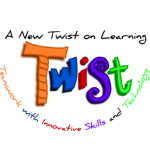Our STEM Maker Fest is the day after tomorrow. Today, one of our group of students who has been working on their project for hours and hours during and after school for weeks got everything up and running. They built a robot from the ground up. It’s a tank with a t-shirt canon on it. They got some help from the robotics team on the programming, but did the majority of the work themselves. Judging by the crowd they drew in the hallway while testing today, they are going to be very popular at the Maker Fest. They even contacted Chik-fil-A for t-shirt donations to shoot from the cannon. So proud of these kids who have been working so hard to make this event a success. Two of the students in this group didn’t have a technology class this year. However, from this project alone they learned much more than most students learn in a year. If you wonder if Maker Ed and Project Based Learning really has a place in schools, you need to see this process in action. This is inspired learning that goes outside of the classroom to real skills that are valuable in today’s society. Give kids a chance to tinker and make! Trust me; you’ll be amazed with what they come up with!
Tag: EdBlogaDay
Our STEM Maker Fest is on Saturday. This weekend, one of my students made this video to encourage students from our feeder middle school to attend. It’s a great video. What’s really cool? She didn’t have to make this awesome video. She decided to make it of her own initiative because she really wants the middle school kids to know about it and attend. It’s just another great example of why I love Maker Ed!
I was looking through my high school yearbook from my senior year in high school. As I read through what people had written, I found this note.
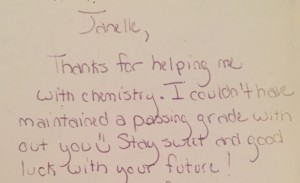
It’s an interesting note for for a couple of reasons. One, I am now teaching chemistry, and I am finishing my ninth year of teaching. I guess helping others understand has always been an interest of mine – especially science. Two, I had my own struggles in chemistry, and I was able to be successful because of my teacher, Mr. Wedel.
At my high school, students generally took biology freshmen year and chemistry sophomore year. Because I went to a private school my freshmen year, I took biology sophomore year and started chemistry my junior year. I was in honors chemistry, and I really enjoyed the class. However, I had some health issues in high school that caused me to miss a lot of school. I was even on hospital/home bound for a few months. I tried switching from honors chem to CP chem, but that didn’t work out well because they were following a different instructional calendar. So, I dropped out of chemistry my junior year and took a science independent research class in its place.
My senior year, I once again enrolled in honors chemistry. During the first semester of the year, I was still having some health issues and missed quite a bit of school. It was nearing the end of the semester, and there was no way I could make up all of my work in time. However, Mr. Wedel, my chemistry teachers (both times), offered me a chance to stay in the class. He believed in me and knew I could do the work and learn the content. He said that if I passed the semester final, I would pass the semester. Well, I did (in fact, I made a “B” on the final). I then went on to do really well second semester (making an “A”) because I didn’t have any absences.
I will forever be grateful to Mr. Wedel for giving me that chance and for believing in me. Plus, I really loved his class. He used to have the best test review games, we did awesome labs, and he had some really cool demos. My favorite thing he taught me was about the Heisenberg Uncertainty Principle (you can know the speed of a subatomic particle or its location, but not both – part of quantum mechanics).
But really, the best thing he taught me wasn’t even about chemistry, and it has made me a better teacher. He taught me to believe in students and to give students second, third, fourth chances. To not let a student give up, and to keep working. And I’m pretty sure my policy of passing the final means passing the class no matter what your grade was prior to that was heavily influenced by him.
So thank you, Mr. Wedel, for being such an awesome chemistry teacher, and thank you for showing me how to be a great teacher!
Today was one of those crazy, long, whirlwind days where you barely have time to catch your breath but at the end of it you realize it was a day filled with awesomeness. for instance, I took my engineering classes outside today to launch the soda-bottle rockets we’ve been working on the past week. Some of my chemistry students asked if they could come out and watch since they didn’t have anything to work on. So they came outside with me and my engineering class and had fun watching the launches. At one point, I turned to look at my chem kids, and I noticed they had tied themselves up in a knot and were untying themselves. (It was the classic team building activity.) I could not have felt more proud of them at that moment. They chose such a fun, constructive way to use their down time!
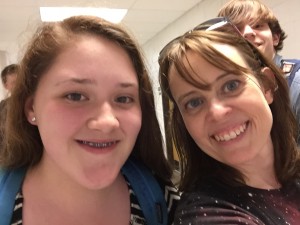 Later in the morning, one of my sophomore chemistry students stopped to take a selfie with me (including an obligatory photo bomb by another one of my students) before she left with the rest of her team for their appointment with the patent attorney about their project. (Getting to their appointment was made even more challenging due to a plane crash on the interstate.)
Later in the morning, one of my sophomore chemistry students stopped to take a selfie with me (including an obligatory photo bomb by another one of my students) before she left with the rest of her team for their appointment with the patent attorney about their project. (Getting to their appointment was made even more challenging due to a plane crash on the interstate.)
Then after school today, I spent over an hour talking with a few students about life, school, goals, and so on. When one of them first came in my classroom, he noticed that desks were disarranged from an earlier activity and some supplies hadn’t been put away. He picked everything up for me and rearranged my desks of his own initiative.
This week, I’ve realized that high school students don’t celebrate Teacher Appreciation Week traditionally. I think this has to do with the fact that they didn’t even know it was Teacher Appreciation Week. However, by the time they reach high school, many students already have a great understanding of what teachers do for them. They don’t need a special week to make us feel appreciated. They know how to make me feel appreciated by the little things in the every day.
Wouldn’t it be nice if teachers were treated like the professionals we really are? I have a unique set of skills and experiences that I believe sets me apart from other educators. I have an excellent rapport with students (at least I like to think I do), I am consistently working to revise and improve lessons, and I seek out new learning all of the time. I spend hours inside and outside of my classroom working to be the best educator I can be. I spend my summers immersing myself in experiences to bring back to the classroom. I have participated in and facilitated experiences that no other teachers have completed in my district. (Seriously – I have had some of the most AMAZING experiences ever – like space camp, advanced space camp, standing under Atlantis, floating in microgravity with NASA, seeing shuttles and rockets launch, helping students interview a NASA scientists live on NASA TV, being a NOAA Teacher at Sea, Creeks to Coast, and facilitating an ISS contact for our students.)
And yet, my salary is exactly the same as any other teacher in my district who has the same number of years of experience and the same degree that I have. Why is that? Shouldn’t there be some value to the unique experiences I provide students? Shouldn’t teachers who go above and beyond be compensated? It would be absurd to give every employee with the same experience and education level the same salary in the corporate world, so why is it the norm in education?
So when will I know that my profession is respected? When teachers become a valuable asset to their schools worth fighting over, I’ll know. When teacher salaries are not dictated by a one-size-fits-all pay scale, I’ll know. When teacher opinions are valued and sought out, I’ll know. When politicians finally realize that teachers know more about educating our nation’s youth than they do, I’ll know.
Teachers are professionals, and it is time for us to be fully respected as such.
(And this would be pretty cool, too.)
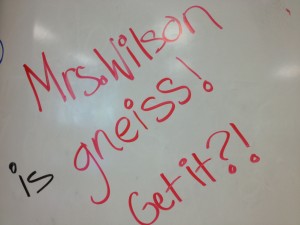 Teaching is
Teaching is
Inquiry and discovery.
Excitement and frustration.
Collaboration and chatter.
Learning that is loud, and messy, and fun.
Impacting the future every day.
Developing relationships and leaving impressions.
Laughter.
Creating and connecting.
Problem solving and making.
An investment of time.
Memory making.
Important and vital.
Love.
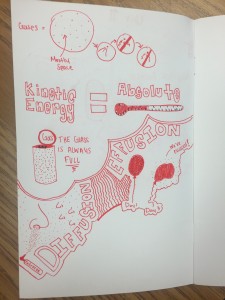
Today we really dived into our gas laws unit. I started today’s lesson by reviewing some basic shapes to help with drawings when using sketchnotes. Mike Rohde outlines these in TheSketchnote Handbook. Almost anything can be drawn in sketchnotes using a rectangle, circle, triangle, line, and dot. We also looked at techniques for drawing people, faces, and type. We created an appendix in our sketchbooks for these techniques. There were a couple of questions about why we were learning art techniques in a science class, but overall, students were really positive.
Before I started the actual lecture on sketchnotes, I reminded students not to worry about the details or information they were really familiar with from the material. Instead, the big idea of sketchnotes is to focus on the big ideas.
When I began going through the lecture section of class, I went rather quickly. Some students were still in the habit of trying to get every word written down. I had to remind them again that they didn’t need to write everything down but rather focus on the big ideas. I was a little worried that perhaps they weren’t getting it, but I should not have been concerned!
I had a chance to go around and check out the student drawings while they were working some practice problems. I was really impressed with what I saw. Most students were really engaged with the information, and their notes looked amazing. I also noticed that some students said they would need to back and finish their notes later because they had details to add. Other students were using the notes handout I passed out near the end of class to supplement the notes they had taken and add in information they had missed. I hope this is a good sign that students will continue to interact with their notes long after class is over.
See the gallery below for all of the awesome student sketchnotes and check out the entire project gallery on Flickr.
 I have a weakness. It is finding balance in my life. There are 14 school days left in the year, and I am using this to justify the long days at school, the weekends filled with work, and hours spent in front of my laptop. However, there is always an excuse for me; the time of year rarely matters.
I have a weakness. It is finding balance in my life. There are 14 school days left in the year, and I am using this to justify the long days at school, the weekends filled with work, and hours spent in front of my laptop. However, there is always an excuse for me; the time of year rarely matters.
But you know what? I shouldn’t think this is okay. Our profession should not place demands on us that require almost as many hours working outside the classroom as we spend inside the classroom. Now, I know not all teachers spend hour upon hour a week working, but I think most, if not all, of the great ones do. Why? Because we care about our students, our profession, and the world.
In the process of caring so much, we forget about someone very important in our classroom.
Ourselves.
We neglect balance in our lives and justify it because we are working with kids and impacting the future. I am the worst at this. I generally start a year with some semblance of balance, but as the year progresses, I become more and more unbalanced. By the time I reach this point of the year, my entire life is school, and I have lost all sense of balance.
This summer, my goal will be to find balance and to establish a plan to maintain balance throughout the school year. I need to find balance between what happens inside of school and what I need to do outside (like take care of me, my husband, my dog, my cats, my house, etc.) Will it be easy? No. Do I always manage my time well? No. Is there a huge room for improvement? Absolutely.
How do you find balance?
Note: I wrote about a similar topic a month ago, so obviously this is a huge weakness for me! Just Breathe
I grew up in Florida. People will often joke that Florida doesn’t have seasons. Of course Florida has seasons; they just aren’t traditional: hurricane season, tourist season, strawberry season, and citrus season are just a few. Growing up in Florida, I always wondered what the big deal is about spring.
When I moved to Georgia almost ten years ago, I finally discovered spring.
Spring
Spring is bliss.
Spring is incandescent.
Spring is buds and flowers and pollen.
Spring is green, verdant and lush.
Spring is hope bursting forth.
Spring is petals floating on the wind.
Spring is bird song greeting the morning.
Spring is bees buzzing.
Spring is world made new.
Spring is the bluest of skies.
Spring is life blossoming.
Spring is love.
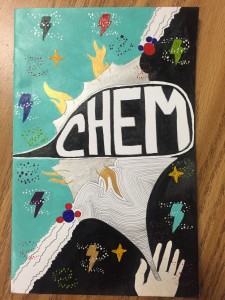
A week ago, I passed out simple bound books to my students (our “sketchbooks”) and asked them to decorate the covers by Thursday (yesterday). When students got to class yesterday, I asked them to start by walking around the room and looking at each others decorated covers.
I spent the next part of class explaining my big idea for sketchnotes. There is actually a lot of great research supporting the use of doodling in the classroom (like this article from LiveScience that explains Doodling May Draw Students into Science). Next, we watched a short video from Mike Rohde explaining the Sketchnote process. After that, I had a short discussion with students to hear their initial thoughts. The biggest concern students had was making sure they had all of the details of the notes. Since Sketchnoting focuses on the big ideas, they were worried they would miss a detail that would be important for an assessment. Except for that, students seemed pretty open to the idea. I had already anticipated that this would be a concern, so I was happy to tell them that they would receive a packet of completed notes for the unit. (We usually do cloze style notes.)
After watching a longer video of the Sketchnoting process in action, students were ready to try it themselves. They were starting to realize that the visual elements did not require a lot of drawing skill. It is more about doodles and lettering. For our first challenge, I displayed the two standards we will be covering this unit.
- 13b. calculate temperature, pressure and volume of gases using Charles’ Law, Boyle’s Law, and Gay-Lussac’s Law
- 13e – use concepts of the mole and Avogadro’s number to calculate the molar volume of gases (GPS)
I then asked students to interpret the standards using sketchnotes based on their prior knowledge and what they thought the standard meant. It was a great way to preview the content of the unit and for students to uncover things they already know.
In the slideshow, you can see some of the decorated covers and initial sketchnotes from students. I think they look amazing for just beginning. I am looking forward to seeing how this plays out. Many students were really excited to have the chance to draw and doodle and were asking if the process could be applied to other classes. Students even suggested I should do this with my students next year!
I am also participating with my students. I think it’s a good idea to model something new (or even well known). I’ve found that students are much more likely to buy in to your crazy ideas if you do it along with them. It shows students that you think it is important enough to do, too. I am so excited to see where this journey takes us, and I hope you’ll continue to follow along!

